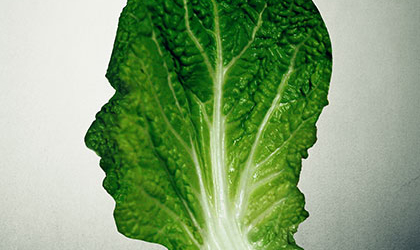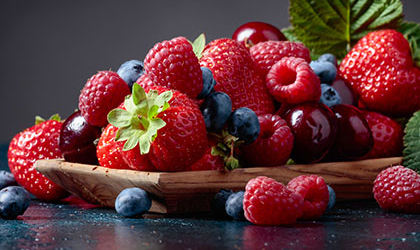
If you’ve done any snooping around the wellness corner of the Internet recently, you will have seen the trendy nutritional term ‘antioxidant’ pop up once or twice. Before you scoff, “not more antioxidant chat”, in truth, these powerhouses couldn’t be more deserving of their moment in the spotlight. They work hard to defend your body against the DNA-destroying compounds, free radicals, which conspire to throw your biological responses out of whack. Antioxidants serve a vitally important role in skin health, immunity, mood, cardiac function, and yes – the wellness of your peepers.
Antioxidants: the science
Your body encounters free radicals every day – as a consequence of normal biological functions and from external stressors, like cigarette smoke, environmental pollution, and UV rays. Free radicals are unstable molecules that penetrate your body and damage everything in their path: DNA, enzymes, and cell membranes, causing what is more scientifically termed, ‘oxidative stress’. Every area of your body is vulnerable to attack from these nefarious compounds – and your eyes aren’t an exception. Fortunately, antioxidants are positioned to defend your body against such destructive invasions. These potent fellas neutralise free radicals in a bid to keep your cellular functions working optimally. But it’s not always this easy; free radicals often outnumber the amount of naturally-occurring antioxidants in your body. To win the fight, you need a constant supply of antioxidants from dietary sources.
Best antioxidants for eye health
Lutein and zeaxanthin
Sure, it may be hackneyed advice by now, but there’s good reason why everyone is telling you to gobble up your greens. Dark leafy greens, like kale, spinach, parsley, and peas, are chock-full of peeper goodness: lutein and zeaxanthin – two antioxidants that are critical for healthy vision. These compounds are found in high concentrations in the macular – the region of your eye that’s needed for detailed, precise vision. Not only do this power duo protect the fragile light receptors in your eyes by filtering out potentially damaging UV rays (hello, natural sunblock), but they’ve also demonstrated immense promise in reducing the risk of age-related macular degeneration and cataracts – both of which impair visioni. Greens aren’t the only eye-friendly foods; egg yolks are also teeming with lutein and zeaxanthin. Spinach omelette, anyone? Learn more about lutein’s impact on eye health here.
Vitamin C
Some might call vitamin C the big daddy of the antioxidant world – and we wouldn’t disagree. This powerful compound serves in countless areas of health, and is especially fantastic food for your peepers. First and foremost, vitamin C supports collagen production – a protein that reinforces the overall structure of your eyes, especially the cornea and sclera. Thanks to it neutralising those destructive free radicals, research suggests vitamin C may also slow the progression of age-related macular degeneration, as well as decrease the chance of cataractsii. One study revealed consuming 490mg of dietary vitamin C reduced the risk of cataracts by an impressive 75%iii. There are countless ways to up your vitamin C intake: add a handful of blueberries to your post-gym smoothie; squeeze lashings of lime juice into homemade guacamole (added bonus: avocado is another antioxidant-rich fruit to nourish your eyes); or enjoy a fruit medley for breakfast – think oranges, grapefruit, pineapple, and raspberries.
Beta-carotene
You’ve probably heard the rumours about carrots and eye health – and yes, there’s some element of truth in them. These tall, orange guys are a great source of the powerful antioxidant, beta-carotene, which – when converted into vitamin A by the body – nourishes the cornea (the surface of the eye). Vitamin A is also a key ingredient of rhodopsin – a protein found in your eyes that enables you to see in low light conditions (now can you understand why your mother insisted eating carrots could help you see in that dark?). Although rare, a vitamin A deficiency can lead to full-blown blindness. Like many of the antioxidants mentioned here, experts purport diets rich in vitamin A may help to reduce the risk of visual impairment from cataracts and age-related macular degenerationiv. Carrots aren’t the only foods bursting with beta-carotene nourishment; sweet potatoes, squash, apricots, red peppers, and dark leafy greens, like spinach and kale, are chock-full of this eye-friendly nutrient, too.
Vitamin E
Another antioxidant worthy of praise is vitamin E. This nutrient powerhouse protects your cells – including those in your eyes – from the pernicious effects of free radicals. Data suggests regularly consuming sources of vitamin E can help reduce the possibility of age-related macular degeneration and cataractsv. Avocados are abundant in vitamin E – not to mention a slew of other powerful peeper-popping nutrients, like beta-carotene, lutein, zeaxanthin, and healthy fats. Add to salads, smash into guacamole, or enjoy with poached eggs (another eye-friendly food, we should add). Almonds are crammed with vitamin E, too. Did you know eating 23 of these heart-shaped nuts will meet your recommended daily allowance of vitamin E (15mg)? Be sure to stash a bag in your office drawer.
Riboflavin
Otherwise known as vitamin B2, this antioxidant excels at reducing oxidative stress in the body, particularly where the eyes are concerned. Experts have widely touted this antioxidant for its ability to prevent cataractsvi. Indeed, many patients with cataracts also exhibit low levels of this antioxidant. One study found a dietary intake of 1.6-2.2 mg was associated with a 30-50% reduced risk of cataracts developmentvii. Be sure to embrace a range of riboflavin-rich food to nourish your eyes: milk, fortified cereals, oats, beef, and yoghurt.
References:
-
Ma, L., Dou, H., Wu, Y., Huang, Y., Huang, Y., Xu, X., Zou, Z. & Lin, Z. B. (2011). Lutein and zeaxanthin intake and the risk of age-related macular degeneration: a systematic review and meta-analysis. British Journal of Nutrition, 107(03), 350-359.
Vu, H. (2006). Does dietary lutein and zeaxanthin increase the risk of age related macular degeneration? The Melbourne Visual Impairment Project. British Journal of Ophthalmology, 90(3), 389-390.
Muriach, M., Bosch-Morell, F., Alexander, G., Blomhoff, R., Barcia, J., Arnal, E., Almansa, I., Romero, Z. & Miranda, M. (2006). Lutein effect on retina and hippocampus of diabetic mice. Free Radical Biology and Medicine, 41(6), 979-984. -
Rasmussen, H.M. & Johnson, E.J. (2013). Nutrients for the aging eye. Clinical interventions in aging, 8, 741-8.
-
Jacques, P., Chylack, L. (1991). Epidemiologic evidence of a role for the antioxidant vitamins and carotenoids in cataract prevention. The American Journal of Clinical Nutrition, 53(1), 352S-355S.
-
Wang, A., Han, J., Jiang, Y. & Zhang, D. (2014). Association of vitamin A and β-carotene with risk for age-related cataract: A meta-analysis. Nutrition, 30(10), 1113-1121.
-
A Randomized, Placebo-Controlled, Clinical Trial of High-Dose Supplementation With Vitamins C and E, Beta Carotene, and Zinc for Age-Related Macular Degeneration and Vision Loss. (2001). Archives of Ophthalmolog, 119(10), 1417.
-
Skalka, H. & Prchal, J. (1981). Cataracts and riboflavin deficiency. The American Journal of Clinical Nutrition, 34(5), 861-863.
-
Mares-Periman, J., Brady, W., Klein, B., Klein, R., Haus, G., Palta, M., Ritter, L. & Shoff, S. (1995). Diet and Nuclear Lens Opacities. American Journal of Epidemiology, 141(4), 322-334.
You Might Also Like

Olivia
Olivia Salter has always been an avid health nut. After graduating from the University of Bristol, she began working for a nutritional consultancy where she discovered her passion for all things wellness-related. There, she executed much of the company’s content marketing strategy and found her niche in health writing, publishing articles in Women’s Health, Mind Body Green, Thrive and Psychologies.
View More



